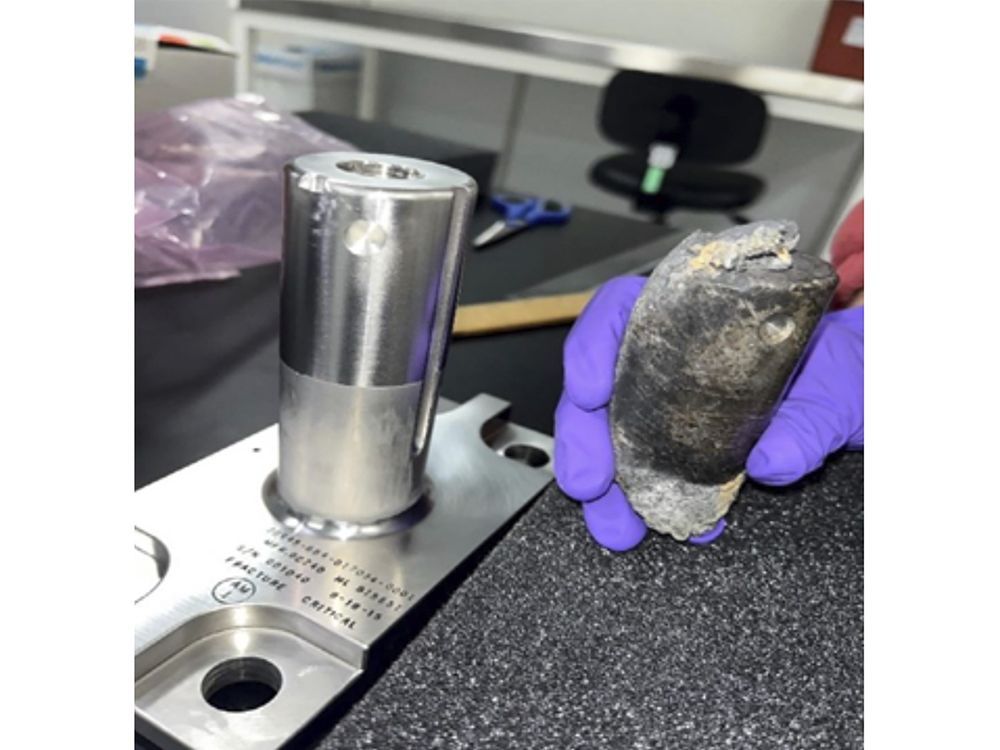Science
Mars very visible in night sky as it moves closer to Earth


|
|
By Gary Boyle
Some three billion years ago, Mars is believed to have been a water world just like Earth. It possessed great oceans and was most likely on its way to forming life in one form or another. Water is made up of hydrogen, the most common element in the universe, and oxygen, the third most common element. Water is extremely important to the development and sustaininment of life as we know it.
Because Mars is half the size of the earth, the planet lost its heat faster as its internal core stopped rotating. Similar to Earth’s core, which produces a magnetic field around our planet, Mars’ core ceased producing its protective magnetic field, thus allowing the solar winds to eat away at its atmosphere, and the red planet lost its water.
Early telescopic observations were made by the Italian astronomer Giovanni Schiaparelli in 1877, when Mars was in opposition, residing 56-million-kilometres away, and he is said to have seen canali (channels) on Mars. Seeing these features gave the impression of a possible civilization. Since then, the red planet has been the focus of searching for ancient life, and is also the inspiration for science fiction writers and movie makers.
By the 2030s or 2040s, humans are expected to land on this fascinating world, looking for the possibility of life that might have once existed, even at the microbial level. After all, life is life. But Mars is now in the news for other reasons: it is now a very visible object in the night sky.
Appearing as a bright-orange object rising in the northeast sky about forty-five minutes after the sun sets in the west, Mars is nicely placed amongst the bright winter constellations of Orion the Hunter, Taurus the Bull, etc. If you are still not sure where to look, any smartphone astronomy app will guide you.
So why is it so bright? Earth orbits the Sun in 365 days, whereas Mars does so in 687 days. Just like runners on the inner lap on a race track, Earth catches up with, and overtakes, slower Mars every 26 months. This upcoming opposition will occur on Dec. 8 at a separation of only 82 million kilometres. Over the weeks after opposition, our distance increases and Mars will slowly fade. Every seventh opposition is super close, such as back in 2003 and 2020. The next opposition occurs on Jan. 15, 2025.
Be sure to look at Mars the night before, on Dec. 7, as the Full Cold Moon will cover Mars for a little less than one hour. All of Canada, as well as much of the US except for Alaska and the Southeastern states, will see this amazing sight. Throughout its 29.5-day orbit around the earth, the moon moves its width every hour. Throughout the month, it covers stars as seen through a telescope and, in rare events, bright planets. This should be a fantastic photo opportunity, as the disappearance and later reappearance should be quite evident.
Clear skies!
Known as “The Backyard Astronomer”, Gary Boyle is an astronomy educator, guest speaker, and monthly columnist for the Royal Astronomical Society of Canada, as well as a STEM educator. In recognition of his public outreach in astronomy, the International Astronomical Union has honoured him with the naming of Asteroid (22406) Garyboyle. Visit his website at www.wondersofastronomy.com.
Science
SFU researchers say ant pheromones could help prevent tick bites – Global News
New research from Simon Fraser University reveals ants could be a solution to prevent tick bites.
In a media release Monday, the university said researchers found that ticks would avoid ants and the area they were in. Even once the ants would leave the area, ticks would still not go to where the ants previously were.
“They could see that there were ants and basically go, ‘I’m not going to go there because there may be ants there or there may be ants there again soon,” said Claire Gooding, the lead author of the study.
The research was published recently in the journal Royal Society Open Science.

Gooding said the team researched ants as a potential solution because the insects work in large groups and use chemicals to communicate.
“They are social insects and use a huge range of pheromones to communicate with one another,” Gooding said.
After discovering the effectiveness of ant pheromones, the team worked with a synthetic chemist and was able to “recreate a synthetic version” of the pheromones.

This synthetic ant pheromone was also successful in repelling ticks.
“There’s quite a big risk of tick encounters in the summer,” said Gooding. “People often encounter them on the sides of trails.”
The study suggests hikers could consider using ant pheromones as a repellent to scare off ticks.
They have a patent application in process for the repellant chemicals they developed.
There are three species of ticks that commonly bite humans. In some cases, if bites are not treated quickly enough, they can prove fatal.
More on Science and Tech
© 2024 Global News, a division of Corus Entertainment Inc.
Science
NASA is seeking a faster, cheaper way to bring Mars samples to Earth – CityNews Toronto


CAPE CANAVERAL, Fla. (AP) — NASA’s plan to bring samples from Mars back to Earth is on hold until there’s a faster, cheaper way, space agency officials said Monday.
Retrieving Mars soil and rocks has been on NASA’s to-do list for decades, but the date kept moving forward, as costs ballooned. A recent independent review put the total cost at $8 billion to $11 billion, with an arrival date of 2040, about a decade later than advertised.
NASA Administrator Bill Nelson said that’s too much and too late. He’s asking private industry and the space agency’s centers to come up with other options to revamp the project. With NASA facing across-the-board budget cuts, he wants to avoid gutting other science projects to finance the Mars sample project.
“We want to get every new and fresh idea that we can,” he said at a news conference.
NASA’s rover Perseverance already has gathered 24 core samples in tubes since landing in 2021 at Mars’ Jezero Crater, an ancient river delta. The goal is more than 30 samples to scour for possible signs of ancient Martian life.
The space agency wants to get at least some of the collected samples to Earth sometime in the 2030s for no more than the $7 billion. That would require a spacecraft that goes to Mars to get the tubes and launches off the planet. Then it must rendezvous with yet another spacecraft that would bring the samples to Earth.
NASA’s science mission chief, Nicky Fox, refused to speculate at the news conference when the samples might arrive at Earth, given a new program and timeline, or even how many samples might be returned. That information will be included in any proposals, she said.
“We’ve never launched from another planet, and that’s actually what makes Mars sample return such a challenging and interesting mission,” Fox said.
Scientists are eager to analyze pristine samples from Mars in their own labs, far superior to the kind of rudimentary testing done by spacecraft at the red planet. It will take such in-depth testing to confirm any evidence of microscopic life dating back billions of years when water flowed on the planet, according to NASA.
The samples will help NASA decide where astronauts go on Mars in the 2040s, Nelson said.
NASA’s Jet Propulsion Laboratory in Pasadena, California, had been in charge of the sample project. It was hit by hundreds of layoffs earlier this year due to all the budget cutbacks. Nelson is seeking ideas from across the space agency, with the revamped program more spread out.
NASA hopes to receive any ideas by late fall.
___
The Associated Press Health and Science Department receives support from the Howard Hughes Medical Institute’s Science and Educational Media Group. The AP is solely responsible for all content.
Marcia Dunn, The Associated Press
Science
NASA confirms mystery object that crashed through roof of Florida home came from space station – Toronto Sun


Article content
NAPLES, Fla. (AP) — NASA confirmed Monday that a mystery object that crashed through the roof of a Florida home last month was a chunk of space junk from equipment discarded at the International Space Station.
Article content
The cylindrical object that tore through the home in Naples on March 8 was subsequently taken to the Kennedy Space Center in Cape Canaveral for analysis.
Article content
The space agency said it was a metal support used to mount old batteries on a cargo pallet for disposal. The pallet was jettisoned from the space station in 2021, and the load was expected to eventually fully burn up on entry into Earth’s atmosphere, but one piece survived.
The chunk of metal weighed 1.6 pounds (0.7 kilograms) and was 4 inches (10 centimetres) tall and roughly 1 1/2 inches (4 centimetres) wide.
Homeowner Alejandro Otero told television station WINK at the time that he was on vacation when his son told him what had happened. Otero came home early to check on the house, finding the object had ripped through his ceiling and torn up the flooring.
“I was shaking. I was completely in disbelief. What are the chances of something landing on my house with such force to cause so much damage,” Otero said. “I’m super grateful that nobody got hurt.”
Share this article in your social network
-
Business23 hours ago
FFAW, ASP Pleased With Resumption of Crab Fishery – VOCM
-
Media24 hours ago
Marjorie Taylor Greene won’t say what happened to her Trump Media stock
-
Media14 hours ago
Trump Media plunges amid plan to issue more shares. It's lost $7 billion in value since its peak. – CBS News
-
Business22 hours ago
Tesla May Be Headed For Massive Layoffs As Woes Mount: Reports – InsideEVs
-
Media23 hours ago
Trump Media stock slides again to bring it nearly 60% below its peak as euphoria fades – National Post
-



 Tech19 hours ago
Tech19 hours agoJava News Roundup: JobRunr 7.0, Introducing the Commonhaus Foundation, Payara Platform, Devnexus – InfoQ.com
-



 Sports18 hours ago
Sports18 hours agoRafael Nadal confirms he’s ready for Barcelona: ‘I’m going to give my all’ – ATP Tour
-



 Sports23 hours ago
Sports23 hours agoPoints and payouts: Scottie Scheffler cements FedExCup top spot with Masters win, earns $3.6M – PGA TOUR – PGA TOUR







